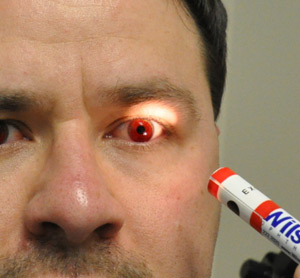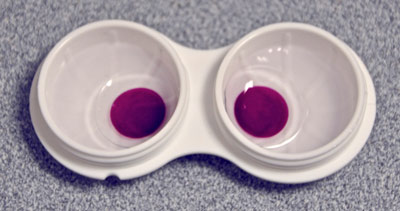Why Red?
“I wear red sunglasses, ……The first time I put them on, I was so thrilled. I ran home admiring all the fall foliage and looking at things more like a color-sighted person does. With these lenses on, I can distinguish between red and black. Previously I had always thought of red as a dark color, but now I know it is a bright color.”
- Achromat Network Member
Red is the most common color of filter used for rod monochromats. However, each achromats is unique and the color and darkness of the tint must be customized to each patient. Rod monochromats may have complete colorblindness or be incomplete with traces of residual color vision, which may affect the color selection.
In our practice, most rod monochromats use red, but amber/brown and gray filters are also used owing to their better cosmetic appearance for some patients. Blue cone monochromats often use a magenta filter to allow some blue through to the retina. With these caveats above, let's now look at the question. Why red?
Let's assume you have complete rod monochromatism. You would have no functioning cones which normally provide vision in high levels of light. You would need to use your rod receptors in all levels of lighting. However, rod cells can function only at low levels of light. Your rod cells quickly bleach out or saturate in bright light, leaving you in bright light without functioning photoreceptors. The brighter the light, the faster and more severely the rods would bleach out, and the more you would struggle to see.
At low light levels, however, you could see to function easily, because the rods receptors use a chemical photopigments that function best in low light.
Creating Night for Day
Thus, to help an achromat see better in the light, we must turn the light level into the night so the rods can function. Night scenes in the movies are often filmed in the daytime with dark filters used to darken the scene.
Any dark filter will reduce the light reaching the retina and may help the achromats begin to see better. However, not all filters are created equal. If we look at the spectrum of light from the sun as it splits apart into a rainbow we see that "white" light is actually made of many different (colors) wavelengths from red on the outside to purple and blue on the inside.
into a rainbow we see that "white" light is actually made of many different (colors) wavelengths from red on the outside to purple and blue on the inside.
Shorter wavelengths like blue light have much higher energy than red light. The red light has only 1/15 the energy of the blue light. Thus red light has less energy to bleach out the rods in the eye. If we use a red filter on a complete rod monochromat, we lessen the bleaching of the rods and allow these individuals to maintain functioning rods to see with in bright light.
Red Lights in Darkrooms
The low energy of red light has been used in darkrooms for decades to work with film without over exposing it. The photographer could safely work with photos under the very low energy of red light.
 Photo Courtesy of Damien Loverso
Photo Courtesy of Damien Loverso
In a similar way, the achromat's red lenses block the higher energy blue end of the spectrum, allowing primarily red light to pass through to the retina.
Bright white light would quickly bleach out the rods receptors owing to the high energy of the shorter wavelength. Red light, however, will not bleach out or saturate the rod cells in the retina. Thus red filters block the higher energy light and lets only the lower energy red light pass to the retina. This protects the rod photopigments allowing the achromat to function in bright light that would otherwise overwhelm them.
Achromats and Submariners: The Benefit of Red
Another example of this concept occurs in the submarines in the navy.  Before surfacing the sub at night, red lights are turned on inside the submarine. This allows the submariner’s eyes to replenish the rod photopigments before surfacing. If not, the rods would be bleached out from the normal inside white lights and the submariner would not be able to spot risks from ships or planes as they surface.
Before surfacing the sub at night, red lights are turned on inside the submarine. This allows the submariner’s eyes to replenish the rod photopigments before surfacing. If not, the rods would be bleached out from the normal inside white lights and the submariner would not be able to spot risks from ships or planes as they surface.
Thus red light is best at preventing the rods from saturating or bleaching out. And, red filters in contacts or eyewear are most effective in preventing bleaching of the rod vision. Other color filters will help, but may not be quite as effective. Other colors, however, may offer improvements in cosmetics or may be need to prevent blocking residual color vision in incomplete color loss. For example, a dark red filter might block green or blue vision in an incomplete achromat who is able to see one of these colors.
There are two ways we can provide red filters or other filters to the achromat.
 First, we can use red filters in eye wear to control inside glare. This is the first choice in children too young to wear contact lenses. Then a very dark sun filter is worn outside. Often special custom dyed filters are required to reach a dark enough level for outside. The sunglass frames must be designed to block light leakage.
First, we can use red filters in eye wear to control inside glare. This is the first choice in children too young to wear contact lenses. Then a very dark sun filter is worn outside. Often special custom dyed filters are required to reach a dark enough level for outside. The sunglass frames must be designed to block light leakage.
 Second, we can use a new type of filtered soft contact lens. Here, we see a red central soft contact lens that is fit to control glare fully inside. Then sunglasses can be worn over the contact lenses outside. Often if contacts are worn, standard sun filters can be worn.
Second, we can use a new type of filtered soft contact lens. Here, we see a red central soft contact lens that is fit to control glare fully inside. Then sunglasses can be worn over the contact lenses outside. Often if contacts are worn, standard sun filters can be worn.
Why Magenta?
Magenta filters may be helpful in blue cone monochromatism and in some incomplete rod monochromats. Blue cone monochromats (BCM) is a rare form of incomplete achromatopsia.  It is inherited as an X-linked condition occurring nearly always in males. In our eyes, we normally have rods and three forms of cones, red, green and blue cones. BCM patients have both rods and blue cones functioning but lack the red and green cone function. Using a solid red filter on these patients may block some of the blue light from reaching the retina and the patient will loose their residual blue color vision.
It is inherited as an X-linked condition occurring nearly always in males. In our eyes, we normally have rods and three forms of cones, red, green and blue cones. BCM patients have both rods and blue cones functioning but lack the red and green cone function. Using a solid red filter on these patients may block some of the blue light from reaching the retina and the patient will loose their residual blue color vision.
To avoid that loss of the remaining blue channel, we must select a filter that allows some blue light to pass through to the retina. Magenta is a good choice for these blue cone monochromats.

Magenta is formed from red and blue dyes. This allows both some red and some blue light to pass through to the retina. This reduces the glare and bleaching of the rods, but allows the blue cone monochromat to still see with the blue channel. Because they have only one color channel, these individuals may not see blue color as we do, but may better see blue colored objects.
